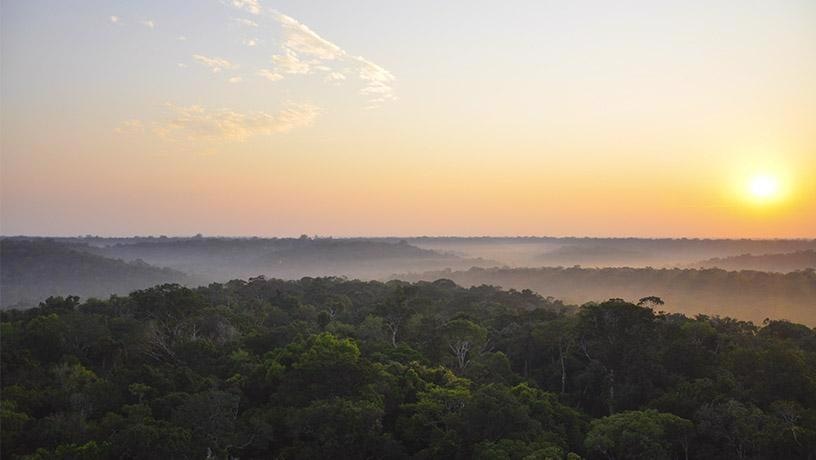Nov 23 2020
Forests could help combat climate change by absorbing carbon dioxide (CO2) during photosynthesis and retaining it in their biomass (roots, tree trunks, etc.). At present, forests absorb about 25%–30% of human-produced CO2 emissions.
 Sunrise over the Amazon rainforest (taken from the top of the K34 flux tower site located 60 km north of Manaus, Brazil). Image Credit: Xi Yang/University of Virginia.
Sunrise over the Amazon rainforest (taken from the top of the K34 flux tower site located 60 km north of Manaus, Brazil). Image Credit: Xi Yang/University of Virginia.
Some rainforest regions, such as the Amazon, store surplus carbon in their biomass than any other ecosystem or forest. However, when forests turn water-stressed (lack of adequate water in the soil and/or very dry air), forests will decelerate or halt photosynthesis. This would result in more CO2 in the air and can cause tree mortality.
The existing Earth system models used for predicting climate illustrate that the Amazon rainforest is extremely sensitive to water stress. Since it is predicted that in the future, the atmosphere will turn drier and warmer with climate change, causing higher water stress, this could have serious repercussions not just for the survival of the forest, but also for its capacity to store CO2.
If the forest is not able to thrive in its present capacity, climate change could significantly accelerate.
Scientists at Columbia Engineering set out to examine whether this was true, whether these forests are truly as sensitive to water stress as indicated by the models. In a study reported recently in Science Advances, they discuss their finding that these models have been fundamentally exaggerating water stress in tropical forests.
The team learned that, while models reveal that increases in air dryness seriously reduce photosynthesis rates in some regions of the Amazon rainforest, the observational data results contradict it: in some very wet regions, the forests even increase photosynthesis rates in reaction to drier air, on the other hand.
To our knowledge, this is the first basin-wide study to demonstrate how—contrary to what models are showing—photosynthesis is in fact increasing in some of the very wet regions of the Amazon rainforest during limited water stress.
Pierre Gentine, Associate Professor of Earth and Environmental Engineering and of Earth and Environmental Sciences, Columbia University
“This increase is linked to atmospheric dryness in addition to radiation and can be largely explained by changes in the photosynthetic capacity of the canopy. As the trees become stressed, they generate more efficient leaves that can more than compensate for water stress,” added Gentine, who is also affiliated with the Earth Institute.
Gentine and his former PhD student Julia Green utilized data from the Intergovernmental Panel on Climate Change’s Coupled Model Intercomparison Project 5 (CMIP5) models and integrated them with machine learning methods to establish the modeled sensitivity of photosynthesis in the tropical regions of the Americas to both air dryness and soil moisture.
Then, they carried out a similar analysis, but this time using observational remote sensing data obtained from satellites instead of the model data, to learn how the observational sensitivity compared. To match their results with smaller-scale processes that could describe them, the researchers then used flux tower data to comprehend their results at the leaf and canopy level.
Previous studies have indicated that toward the end of the dry season, the greenness in the Amazon basin increases, when both the air and soil are drier, and some have related this to increases in photosynthesis.
But before our study, it was still unclear whether these results translated to an effect over a larger region, and they had never been connected to air dryness in addition to light. Our results mean that the current models are overestimating carbon losses in the Amazon rainforest due to climate change. Thus, in this particular region, these forests may in fact be able to sustain photosynthesis rates, or even increase it, with some warming and drying in the future.
Julia Green, Postdoctoral Research Associate, Le Laboratoire des Sciences du Climat et de l’Environnement, France
However, according to Gentine and Green, this sensitivity was established using only current data and, if dryness levels increase to levels that are not presently observed, this could shift. In fact, the team discovered a tipping point for the most severe episodes of dryness stress where the forest could not preserve its level of photosynthesis. Thus, Gentine and Green note, “our findings are certainly not an excuse to not reduce our carbon emissions.”
Gentine and Green have been analyzing themes associated with vegetation water stress in the tropics. Green is presently looking to create a water stress indicator using remote sensing data (a dataset that can be used to recognize when a forest undergoes stressful conditions), measuring the effects of water stress on plant carbon uptake, and associating them with ecosystem traits.
So much of the scientific research coming out these days is that with climate change, our current ecosystems might not be able to survive, potentially leading to the acceleration of global warming due to feedbacks. It was nice to see that maybe some of our estimates of approaching mortality in the Amazon rainforest may not be quite as dire as we previously thought.
Pierre Gentine, Associate Professor of Earth and Environmental Engineering and of Earth and Environmental Sciences, Columbia University
Journal Reference:
Green, J. K., et al. (2020) Amazon rainforest photosynthesis increases in response to atmospheric dryness. Science Advances. doi.org/10.1126/sciadv.abb7232.